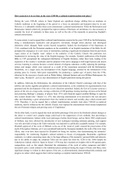How accurate is it to say that, in the years 1509-88, a cultural transformation took place?
During the years 1509-88, culture in Tudor England saw significant change, shifting from an emphasis on
Catholic traditions at the beginning of the period to a focus on nationalist and humanist ideas by its end.
However, it is debatable whether these years demonstrate a cultural transformation. While the Reformation and
Renaissance indeed collectively prompted the rapid evolution of literature, art and drama, it is also necessary to
consider the level of continuity in these areas, as well as the role of the monarchs in preserving England’s
cultural conservatism.
To some extent, it can be argued that a cultural transformation occurred in the years 1509-88 as the Reformation,
being a simultaneously destructive and progressive movement, brought about physical and ideological
alterations which changed Tudor society beyond recognition. Indeed, the development of the Supremacy in
1534, combined with the Protestant emphasis on the availability of an English translation of the Bible for all,
prompted the emergence of a new sense of nationalism, marking a significant development from the previously
vague notion of an English ‘state’ subject to the authority of the Catholic Church; this patriotism was
fundamental in increasing the value of the English language. For example, Tyndale’s publication of the English
Bible in 1525 precipitated the widespread distribution of English literature, rather than Latin, leading to the
expansion of the country’s vocabulary and the adoption of the native language in both legal business and church
services; listening to sermons became a crucial element of religious education, swiftly replacing the paintings,
statues and images which were removed as a result of the iconoclasm associated with the Reformation.
Meanwhile, on a larger scale, the development of the English language, assisted by the introduction of the
printing press by Caxton, held great responsibility for producing a ‘golden age’ of poetry from the 1570s,
allowing for the successes of poets such as Philip Sidney, Edmund Spenser and even William Shakespeare; the
latter’s play, ‘Richard II’, acts as a key demonstration of English patriotism during this period.
In addition, following the Reformation, the substitution of the Catholic Church’s patronage with that of the
nobility and royalty arguably precipitated a cultural transformation, as the conditions for experimentation were
generated and the development of the arts in new directions permitted. Indeed, the Earl of Leicester acted as a
patron of the arts on a large scale, owning a collection of 220 paintings, hosting meetings of poets on the Strand
and protecting Burbage’s company of players from 1574; such financial support enabled Burbage to open the
first London theatre (the ‘Theatre’) in 1576, thus allowing entertainment to be provided to the rich and poor
alike and illustrating a great advancement from the medieval miracle and morality plays which existed until
1574. Therefore, it can be argued that a cultural transformation certainly took place 1509-88 as medieval
traditions, heavily influenced by the Catholic Church, were replaced by entertainment which instead emphasised
the new Protestant religion and growing sense of ‘Englishness’.
On the other hand, it can be argued that royal and noble patronage of the arts in fact hindered cultural changes as
the desire to control one’s popular image could lead to the suppression of new methods, thus preventing a
cultural transformation. Indeed, while royal patronage of artists from Europe, such as Henry VIII’s employment
of Holbein, may have allowed the introduction of new techniques including miniature painting, such support
was only provided as long as the Tudor monarchy was depicted in a politically acceptable manner. For example,
Elizabeth approved of the work of Hilliard, as his use of the ‘mask of youth’ ensured the preservation of the
myth of the ageless Gloriana, yet it was considered backward by European standards; the work of his rival, Isaac
Oliver, may even have been rejected by Elizabeth for being too realistic, thus demonstrating the monarchs’
responsibility for reinforcing England’s cultural isolation in favour of propaganda. Meanwhile, significant
continuity is evident concerning music due to the large influence of the monarchs’ personal faiths and interests;
due to his ability to adapt, the composer Tallis saw his career last from the 1520s to the 1580s despite his
Catholicism. Indeed, while his ‘Spem in Alium’ (1570) may have reached new heights with its 40 separate parts,
compositions such as this simply illustrated the culmination of the work of earlier composers and didn’t
necessarily pose a stark contrast to the traditional pieces produced during the reigns of Henry and Mary; more
significant change is evident in other aspects of the arts, as aforementioned, demonstrating both continuity and
progress in culture which suggests that it did not undergo a complete transformation 1509-88.




